WINNERS AGAIN: For the fifth year in a row, Gwinnett County Parks and Recreation (GCPR) wins first place at the annual Georgia Recreation and Park Association State Lifeguarding Competition, held at Lake Oconee in Greene County on July 18. Those participating came from several different aquatics facilities throughout Gwinnett County. From left are, back row, Daniel Lammons, Brad Miller, Philip Jenny, Jordan Rubin and Arthur Bedard. On the front row are Reagan Balog and Holly Smith. All are seasoned veterans of lifeguarding who have participated in the state competition in prior years. Jordan Rubin is a college student, working summers as a pool manager at Rhodes Jordan Park Pool in Lawrenceville. Holly Smith is a pool manager at Dacula Park Pool. Daniel Lammons and Reagan Balog, both upcoming freshman in college, work summers at Collins Hill Park Aquatic Center alongside Brad Miller and Philip Jenny. The team took first in the written exam, CPR, triathlon and rescue events, second in the swim relay and rescue paddle board event. The team was coached by Arthur Bedard from Mountain Park Aquatic Center.
TODAY’S FOCUS: Having Affordable Health Care Should Not Be a Financial Burden
EEB PERSPECTIVE: There Are Several Reasons for Visiting Canada These Hot Times
SPOTLIGHT: Gwinnett Village Community Improvement District
UPCOMING: County Calls for Six Year SPLOST Referendum on November Ballot
NOTABLE: Jackson EMC Promotes Two Long Term Employees in Restructuring
RECOMMENDED: Winston Churchill Reporting by Simon Read
GEORGIA TIDBIT: Georgia Native George Foster Peabody Gave Back Liberally to the State
CALENDAR: Good Samaritan Health Clinic Plans Open House Monday Morning
TODAY’S QUOTE: When People Will Realize That You Are A Failure
MYSTERY PHOTO: How George Graf Identified the Recent Mystery Photo
LAGNIAPPE: New Mural Surfaces at Key Suwanee Intersection
TODAY’S FOCUSHaving affordable health care should not be a financial burden
By Jack Bernard, Peachtree City, Ga. | So far, over 12 million people have been enrolled in health insurance exchanges under the Affordable Care Act. Millions more have gotten Medicaid via the expansion option, for a total of 20 million. Obviously, there is still a long way to go to achieve full coverage for all of our citizens, but we should not denigrate our progress thus far. Let us remind you of what we faced before the first open enrollment period began in October, 2013.
According to the August 2013 Kaiser Family Foundation Health Tracking Poll, confusion about the Affordable Care Act (also called the ACA or Obamacare) was high before implementation began. Roughly half the public (51 percent) said that they did not have enough information about the ACA to understand how it would impact them and their family.
The share who felt that they didn’t have enough information was particularly high among Hispanics (64 percent), the uninsured (62 percent), young adults (62 percent of those ages 18-25), and those with lower incomes (60 percent of those with family incomes less than $40,000 per year). Further, a large share were confused about the law’s status, with 44 percent either thinking the law had been repealed (8 percent); overturned by the Supreme Court (5 percent); or unsure whether it remained the law or not (31 percent).
The law was passed because there were 50 million of our friends and neighbors (including 2 million Georgians) without health care in this nation, the wealthiest in the history of man. Plus, approximately 50,000 of our residents died each year because of the lack of insurance. This deplorable situation was directly addressed by the ACA and is the main reason that Congress originally passed this historic law in 2010.
So what did the health insurance marketplaces that were established in various states and by the federal government mean for consumers? Consumers were able to compare prices and shop for private health insurance in the “health insurance marketplace” established either online or by phone. Many were able to get help paying for their new insurance, according to income guidelines, as explained below.
Regardless of the plan chosen, the new law required that:
- The insurance has to cover basics like doctor visits, hospitalizations, maternity care, emergency room care, prescriptions, and more.
- Insurance plans cannot deny coverage to consumers with a pre-existing condition.
- All insurance plans will have to show the costs and what is covered in simple language with no fine print.
Additionally, there were trained personnel (“Navigators”) certified by the government and available to provide in-person assistance to help them understand the new coverage options. In the tradition of private enterprise, citizens were able to shop for, compare and choose a private insurance plan which suited their needs. And no one could be denied coverage because they are sick or have a preexisting condition like asthma, diabetes or even cancer.
There is still a lot of misinformation about health care policies being unaffordable under the ACA. In fact, this is not true for the vast majority of our citizens. Some 84 percent of Americans who enrolled through the Health Insurance Marketplace received financial help to lower their monthly premiums. This is by design.
Having health care coverage should not be a financial burden. We believe that because Americans are caring people, the public will ultimately agree, supporting the ACA and efforts to enroll the uninsured.
- To learn more, visit www.GetCoveredAmerica.org.
There are several reasons for visiting Canada in these hot times

Gower Street, St. John’s, Newfoundland. More photos.
By Elliott Brack, editor and publisher | There are several reasons for you to visit Canada these days. We just returned from a nice trip to St. John’s, Newfoundland. Here are reasons to go to Canada now.
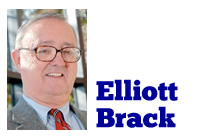 First, it’s cool. We left 95 degrees in Georgia, flew to Toronto, had a two-hour layover and arrived after nine hours’ travel in St. John’s to 50 degree weather. During the entire 10 days there, it never got beyond 72 degrees.
First, it’s cool. We left 95 degrees in Georgia, flew to Toronto, had a two-hour layover and arrived after nine hours’ travel in St. John’s to 50 degree weather. During the entire 10 days there, it never got beyond 72 degrees.
It’s economical. For every American dollar you get 1.3 Canadian dollars. That’s a continuing bargain.
It’s friendly. The Canadians like Americans, and share with us many views, including the surprising Trump accomplishments. They gladly welcome U.S. tourists.
Another reason to visit: the electricity is the same as in the USA, 110 volts, which means you can attach American plugs and not have to worry about frying your device, or fool with transformers.
Grocery shopping is a pleasure in well-maintained supermarkets. (Some have indoor parking.) We even found they stocked Vidalia onions in St. John’s!
It’s historic, the oldest city in North America. St. John’s, Newfoundland, was visited by the Italian explorer Giovanni Caboto (who we know as John Cabot) in 1497. By 1527, a British sailor reported finding Norman, Breton and Portuguese ships in its spacious harbor at St. John’s. That pales in comparison to the founding of St. Augustine, Fla. in 1565.
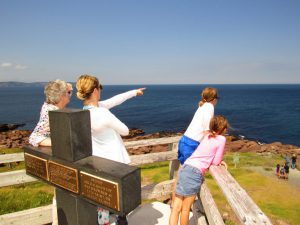 St. John’s is the most eastern of North American cities, closer to Europe than any other city on this continent. It’s only 1,957 miles from St. Johns to Ireland. We visited gusty Cape Spear, the most eastern part of Newfoundland, about 15 miles from St. John’s. It’s a beautiful area, with its lighthouse and open areas. While there, we got a glimpse of whales feasting on the small capelin fish, which appear annually in July.
St. John’s is the most eastern of North American cities, closer to Europe than any other city on this continent. It’s only 1,957 miles from St. Johns to Ireland. We visited gusty Cape Spear, the most eastern part of Newfoundland, about 15 miles from St. John’s. It’s a beautiful area, with its lighthouse and open areas. While there, we got a glimpse of whales feasting on the small capelin fish, which appear annually in July.
Icebergs: Though we were a little late (June is a better time), we still glimpsed three icebergs in the Atlantic off the coast north of St. John’s. The area between Greenland and Newfoundland and Labrador has the highest concentration of icebergs in the world. And it was off the Grand Banks, just southeast of St. John’s, where the Titanic was sunk. The Johnson Geo Centre, a terrific science museum in St. John’s, which we visited, has a captivating exhibit on the sinking of the Titanic. It is the clearest and most comprehensive exhibit of this disaster we’ve ever seen. It’s a must-see for anyone visiting in the area.
The Geo Center is on Signal Hill. The hill gets the name from where the first transatlantic wireless transmission from Cornwell, in the United Kingdom, to Newfoundland took place with Guglielmo Marconi in 1901. Today it’s featured as a historic site.
The entrance to the St. John’s harbor is entered through the Narrows, about a half mile wide, though deep enough for ocean liners to navigate to their downtown dockings. You also see giant icebreakers routinely in the harbor, which continually service the oil rigs in the North Atlantic about 200 miles away.
Though fishing has historically been the major money-maker in St. John’s, it still has its role, though petroleum drives the lions’ share of the economy these days. Newfoundland, three times the size of Georgia, is mainly rocky from ancient glaciers, with only 3 percent of arable land and little agriculture.
Why did we go to Newfoundland? We’d never been. It’s a great spot for Americans to visit, especially during the Dog Days of summer.
- Check out several photos by Andy Brack from Newfoundland here at a sister publication, Charleston Currents.
Gwinnett Village Community Improvement District
 The public spiritedness of our sponsors allows us to bring GwinnettForum.com to you at no cost to readers. The Gwinnett Village Community Improvement District was formed in 2006, and is a self taxing revitalization district that includes just over 800 commercial property owners with a property value of over $1 billion dollars. Gwinnett Village CID includes the southwestern part of Gwinnett County including properties along Jimmy Carter Boulevard, Buford Highway, Indian Trail, Beaver Ruin, and Singleton Road. Gwinnett Village is one of four CIDs to be created in Gwinnett County and is the largest of all CIDs in the state. Gwinnett Village’s mission is to improve property values through increased security, a decrease in traffic congestion, and general improvements to the curb appeal of the area.
The public spiritedness of our sponsors allows us to bring GwinnettForum.com to you at no cost to readers. The Gwinnett Village Community Improvement District was formed in 2006, and is a self taxing revitalization district that includes just over 800 commercial property owners with a property value of over $1 billion dollars. Gwinnett Village CID includes the southwestern part of Gwinnett County including properties along Jimmy Carter Boulevard, Buford Highway, Indian Trail, Beaver Ruin, and Singleton Road. Gwinnett Village is one of four CIDs to be created in Gwinnett County and is the largest of all CIDs in the state. Gwinnett Village’s mission is to improve property values through increased security, a decrease in traffic congestion, and general improvements to the curb appeal of the area.
- For more information visit www.gwinnettvillage.com or call 770-449-6542.
- For a list of other sponsors of this forum, go to: Our sponsors.
- Send us your thoughts: We encourage you to send us your letters and thoughts on issues raised in GwinnettForum. Please limit comments to 200 words. We reserve the right to edit for clarity and length. Send feedback and letters to: elliott@brack.net
County calls for 6-year SPLOST referendum on November ballot
Gwinnett commissioners on Tuesday officially called for a referendum to be placed on the November 8 general election ballot for the renewal of the one-cent special purpose local option sales tax, or SPLOST. The current SPLOST program ends next March. The proposed SPLOST could raise $950 million over its six-year span.
![]() Board of Commissioners Chairman Charlotte Nash says: “Transportation improvements continue to be our biggest need and local government leaders agreed that everyone who uses our roads should help pay the cost of improvements. And as we have done in the past, the County will form another citizens committee soon to review and prioritize prospective transportation project categories.”
Board of Commissioners Chairman Charlotte Nash says: “Transportation improvements continue to be our biggest need and local government leaders agreed that everyone who uses our roads should help pay the cost of improvements. And as we have done in the past, the County will form another citizens committee soon to review and prioritize prospective transportation project categories.”
The County and all 16 Gwinnett cities have again agreed to share the proceeds, as they have since 2001. The new program could raise an estimated $950 million over six years. It will be used for transportation improvements along with public safety, parks and recreation, library relocations and renovations, civic center expansion, senior service facilities and city administrative, parking and cultural facilities plus city water and sewer capital improvements.
Gwinnett County will receive 78.76 percent of the proceeds and the cities will receive 21.24 percent. The County has determined that 65 percent of its share, or an estimated $486 million, will be dedicated to transportation projects such as roads, streets, bridges and sidewalks, including $30.8 million for joint city/county transportation projects. The County has also agreed to set aside approximately $3.2 million for joint parks and recreation improvements.
Gwinnett voters have approved a nearly continuous series of SPLOST programs since 1985 that have raised more than $2.9 billion, allowing the County to minimize long-term debt and save more than $1 billion in financing costs compared to issuing bonds.
The current SPLOST ends on March 31, 2017, and is expected to generate about $453 million, with more than half devoted to transportation projects and the rest going to public safety, parks, libraries, senior services, and city improvements. Additional information about SPLOST can be found online at www.gwinnettSPLOST.com.
Duluth citizens asked to take survey to update park plan
The City of Duluth Parks and Recreation Department is undergoing an update to the Parks and Recreation Master Plan and seeks input from its residents. The city seeks input to understand how the Parks System can best serve its citizens. They may fill out the survey at https://www.surveymonkey.com/r/DuluthParkSurvey2016. The survey takes approximately 10-15 minutes to fill out and will close on August 1, 2016.
Create more art in Kudzu Center classes this summer and fall
 Late summer and fall brings exciting new classes and opportunities to exercise creative muses at Kudzu Art Zone in Norcross with these fun, informative classes. They include:
Late summer and fall brings exciting new classes and opportunities to exercise creative muses at Kudzu Art Zone in Norcross with these fun, informative classes. They include:
- Cartooning for Teens and Cool Adults with Lawrence Hardy – Saturdays, through August 13, 10 a.m. to noon.
- Experimenting with Watercolor with Kathy Kitz Mondays, July 25 to August 22, 10 a.m. to 12:30 p.m.
- Landscape Workshop with Emphasis on Bringing Plein Air into the Studio Wednesday August 17 to Friday August 19, 9:30 a.m. to 4:30 p.m.
- Painting Flowers Alla Prima in Oil with Pat Fiorello Wednesday September 7 to Friday September 9, 10 a.m. to 4 p.m.
- Experimenting with Watercolor with Kathy Kitz (Fall Session) Mondays, September 12 to October 17, 10 a.m. to 2 p.m.
- Painting with Chris Sherry Wednesdays September 14 to October 19, 1:30 p.m. to 4:30 p.m.
For additional information or to register for classes check the website: www.kudzuartzone.org or call 770-840-9844.
NOTABLEJackson EMC promotes two long-term employees in restructuring
Jackson Electric Membership Corporation (EMC) is restructuring its operations and has prompted two long-term employees in executive positions.
Roy Stowe, currently vice president of marketing and member relations, has been appointed COO, and Greg Keith, currently vice president of finance and accounting, has been appointed CFO, effective immediately. Both will report to Jackson EMC’s President/CEO Chip Jakins.
Jakins says: “We believe this realignment will harness the teamwork of the functions that directly provide service to our members, and do the same for the functions that provide the internal support required to make that service possible. By working as a team, those related functions will be able to bring better coordination and efficiency to their work, as well as stimulate innovation in how we operate, and continually improve our service quality. Having Roy and Greg in these positions will take advantage of the more than 60 years of combined experience they have with this organization, which is invaluable in terms of institutional knowledge, as well as their commitment to this organization’s tradition of service to our members.”
Stowe has worked for Jackson EMC for 32 years, holding the position of vice president, marketing and member relations. He was also the director of commercial and industrial sales where he managed a sales force responsible for working with new and existing large business expanding into the company’s northeast Georgia service area.
Keith has worked for Jackson EMC for 31 years as vice president, finance and accounting. Prior to joining Jackson EMC, he held a variety of management positions in the poultry industry.
Reporting to Stowe will be Communications, Engineering and Operations, Information Technology, and Marketing and Member Relations. Reporting to Keith will be Finance and Accounting, Human Resources, Operations Support Services, and Strategic Planning and Analytics. The heads of those functional areas will be named over the next five months.
Jakins adds: “We’re in an enviable position. Most corporations reorganize to cut people or costs, or to shore up issues with their service or image. We don’t have any of those problems. We simply want to build on this cooperative’s tradition of providing high quality service to our members. Roy and Greg are being charged with making that happen.”
Holland becomes director of Gwinnett Planning and Development
Gwinnett County Administrator Glenn Stephens has appointed Kathy Holland as director of the Department of Planning and Development. The Board of Commissioners ratified her employment agreement during Tuesday’s meeting. The department consists of planning, development and strategic infrastructure planning divisions. Holland has served as the acting department director since last November. Born in Ohio, she moved to Georgia with her family in 1968. She worked as a senior development review analyst at Gwinnett County for 15 years before leaving in 1997 to start her own consulting business. Holland returned to the County in 2002 as development review manager. She was promoted to development division director in January 2005 and then became the department’s deputy director in March 2014. She lives in Pendergrass and is married with two children and five grandchildren. Holland replaces Bryan Lackey, who left last year to become Gainesville’s city manager.
Three renewal energy facilities were unveiled July 21 in Buford
Three new renewable energy facilities will be unveiled at the Richland Creek Landfill in Buford on Thursday, July 21.
Republic Services, Inc. (NYSE: RSG) and Mas Energy unveiled these new facilities serving the greater Atlanta area. Combined, these facilities will generate 24.1 megawatts of energy which has the capacity of powering 15,665 local households. Located in the cities of Winder, Buford, and Griffin, the facilities will represent one of the largest Landfill-Gas-to-Energy portfolios in Georgia today.
Among dignitaries at the unveiling will be Michael Hall, Principal and Chief Development Officer, Mas Energy; Jamey Amick, area president, Republic Services; and Bryan Kerlin, Buford city manager.
RECOMMENDEDWinston Churchill Reporting
A book by Simon Read
 Just out of Sandhurst, between 1895 and 1900, Winston Churchill sought to make a name for himself in war-time combat. He was a war correspondent, attached to front-line units in Cuba with the Spanish, on the NorthWest frontier in India, on the Nile in Africa, and later on the plains of South Africa in the Boer War. Often in the front of battle, he somehow escaped serious wounds as bullets flew around him. With his close-up reporting of British wars, he made himself famous, and learned lessons it took him 40 years later to apply. Meanwhile, his wartime correspondence led to several best-selling books, and making him English pounds to live the good life. And, while young, he was elected to parliament. The author relies on private letters and Churchill’s own war reporting in recounting these exploits. A good read of Winston’s early career.–eeb
Just out of Sandhurst, between 1895 and 1900, Winston Churchill sought to make a name for himself in war-time combat. He was a war correspondent, attached to front-line units in Cuba with the Spanish, on the NorthWest frontier in India, on the Nile in Africa, and later on the plains of South Africa in the Boer War. Often in the front of battle, he somehow escaped serious wounds as bullets flew around him. With his close-up reporting of British wars, he made himself famous, and learned lessons it took him 40 years later to apply. Meanwhile, his wartime correspondence led to several best-selling books, and making him English pounds to live the good life. And, while young, he was elected to parliament. The author relies on private letters and Churchill’s own war reporting in recounting these exploits. A good read of Winston’s early career.–eeb
An invitation: what books, restaurants, movies or web sites have you enjoyed recently? Send us your recent selection, along with a short paragraph (100 words) as to why you liked this, plus what you plan to visit or read next. –eeb
GEORGIA ENCYCLOPEDIA TIDBITGeorgia native George Foster Peabody gave back liberally to the state
George Foster Peabody, noted banker and businessman, left his mark on American society through his philanthropic work. He was born on July 27, 1852, in Columbus, Ga., the oldest of four children born to native New Englanders Elvira and George Henry Peabody. Peabody’s father had relocated the family from Connecticut to Columbus, where he ran a general store.
Growing up in Columbus, Peabody attended private school and later studied at Deer Hill Institute in Danbury, Connecticut. The Civil War (1861-65) pushed the family into poverty, and by 1866 they had relocated to Brooklyn, N.Y., where the 14-year-old Peabody took a job with a wholesale dry goods firm.
The mercantile business proved to be a good choice for Peabody. He joined the Reformed Church of Brooklyn Heights, where he met investment banker Spencer Trask, who became not only a good friend but a business partner as well. In 1881 Peabody became a partner in Trask’s new investment firm, Spencer Trask and Company. During the 1880s and 1890s the company began to work in several lucrative fields, including electrical construction financing and railroad construction in the western United States.
Peabody ran most of the company’s railroad investments. Cognizant of such undesirable business practices as rate wars, which were beginning to proliferate in the railroad industry, Peabody advocated government ownership of railroads, and he believed regulation could be the first step in correcting these practices.
After Peabody joined the Episcopal Church in 1880, he became concerned with promoting education, both within the church and in the South. He was a member of the board of trustees for the American Church Institute for Negroes, which funded Episcopal schools in the South; the Penn Normal Industrial and Agricultural School in St. Helena, S.C.; Hampton Institute in Hampton, Va.; Tuskegee Institute in Tuskegee, Ala. ; and the University of Georgia in Athens. Peabody gave money for new buildings and also for the development of new programs and schools at these institutions.
His interest in the University of Georgia was sparked by meeting Andrew Patterson, a physics professor from the university, while Peabody was attending a Southern Education Conference. Peabody accepted an invitation from Patterson to attend the school’s centennial celebration in 1885, and at the end of his time in Athens, he was committed to helping the institution achieve greater stature.
By the 1900s Peabody’s philanthropic work in education included serving as the treasurer for three boards: the Southern Education Board, the General Education Board, and the Negro Rural School Fund. In 1903 he was granted honorary degrees by both Harvard University and Washington and Lee University.
An interest in the education system of his native state led Peabody to become one of the University of Georgia’s main benefactors. The Peabody Awards, the most prestigious awards given in broadcasting, are awarded by the Grady College of Journalism and Mass Communication at the University of Georgia and bear not only Peabody’s name but also his likeness on the medals.
The awards were first given out in 1941. His adopted daughter, Marjorie Peabody Waite, served on the first Peabody advisory board and commissioned the design of the medals. Peabody was also awarded an honorary degree from the University of Georgia and made a life trustee of the university by a special legislative act in 1906.
In 1921 Peabody married Katrina Trask, the widow of Spencer Trask, on their 400-acre estate in Saratoga Springs, N.Y. Katrina Trask, who had been in frail health, died on January 8, 1922, less than a year after their marriage.
In 1923 Peabody purchased a residence at Warm Springs, where he died on March 4, 1938. His ashes were later interred in New York in a grave near his wife.
- For more from the Georgia Encyclopedia online, go to http://www.georgiaencyclopedia.org
How George Graf identified the recent Mystery Photo
This edition’s Mystery Photo shows mansard roofs, reminding you of traditional architecture from an European castle. But are they? Figure out where this is and send your thoughts to elliott@gwinnettforum.com. Be sure to include your hometown.
 ONLY ONE PERSON identified the cruise ship and location of the last Mystery Photo. It came from George Graf of Palmyra, Va., who said that the photo was …taken from “The Battery which lies under the slopes of Signal Hill in St. John’s, Newfoundland.” He added: “More specifically, the yellow house in the photo is on Battery Road and received the City of St. John’s 2015 Heritage Award. Also, the Oceana Insignia cruise ship is heading out of St. John’s harbor into ‘The Narrows,’ then into the North Atlantic Ocean. Additional info. Signal Hill is a hill which overlooks the city of St. John’s. The first transatlantic wireless transmission was received here by Guglielmo Marconi on 12 December 1901. The Battery is home to Chain Rock, a land outcropping to which a large chain and anti-submarine boom were attached during World War II connecting to Fort Amherst in order to prevent the entry of German U-boats into the harbor.”
ONLY ONE PERSON identified the cruise ship and location of the last Mystery Photo. It came from George Graf of Palmyra, Va., who said that the photo was …taken from “The Battery which lies under the slopes of Signal Hill in St. John’s, Newfoundland.” He added: “More specifically, the yellow house in the photo is on Battery Road and received the City of St. John’s 2015 Heritage Award. Also, the Oceana Insignia cruise ship is heading out of St. John’s harbor into ‘The Narrows,’ then into the North Atlantic Ocean. Additional info. Signal Hill is a hill which overlooks the city of St. John’s. The first transatlantic wireless transmission was received here by Guglielmo Marconi on 12 December 1901. The Battery is home to Chain Rock, a land outcropping to which a large chain and anti-submarine boom were attached during World War II connecting to Fort Amherst in order to prevent the entry of German U-boats into the harbor.”
Whew! It was a difficult Mystery Photo, so we asked Mr. Graf how he learned all this from identifying the simple photo. His response is worthy of publication, perhaps to help others search out clues in trying to identify Mystery Photos.
He says: “It was more difficult than usual, at least for me. There were few clues and since the only place in Canada I’ve ever been is Niagara Falls, I couldn’t rely on memories.
“The first clue was the “O” logo on the cruise ship exhaust stack. It took some digging to find it was a small cruise ship called Oceana, but they had a number of cruise ships. So, looked at all the photos of their ships and counted windows on the stern of the ships, which I isolated as the Insignia cruise ship as the best match.
“Next was looking at all the itineraries of the Insignia line, which was discouraging since it sails all over the North Atlantic and Baltic to many destinations that are chilly and foggy, which gave too many possibilities since your photo might not even be at a port stop.
“So I went back to the photo and saw power lines above ground going over the top of the yellow house. A helpful clue for me since living in Germany with the U.S. Army, I remembered that most all power lines are buried underground in Europe. So I figured it was somewhere on our side of the North Atlantic outside of Europe.
“Not seeing palm trees seemed to eliminate any isolated trips to tropical destinations. First I tried Greenland on a hunch, but nothing looked remotely possible. Next I saw the Insignia had a port call at Bar Harbor, Maine, which was extremely close to your last Mystery Photo answer, but no images looked promising.
“Next stop after Bar Harbor was St. John’s. I looked at lots of images and the harbor entrance seemed to fit the image. I went to Google Satellite view and looked at views from each side of the harbor and the Signal Hill side seemed like a possibility. I went to Google Maps a number of times with street views of the harbor and trying to find any address with “53” as the number. No dice. Couldn’t find a street address match, but I kept looking. Finally, I struck an image with the search terms of ‘53, Yellow, St John’s, Signal Hill’ and a few others. About 75 images into the list, I saw the exact yellow house from a different angle. I got the exact address and typed it in. I found out about the Heritage Award at that address and the view matched your photo , though no fog or cruise ship in the view. So, that is a long story made longer as to how I found the answer to the Mystery Photo.”
Lots of people enjoy trying to identify these Mystery Photos, but George takes the cake in sticking to it!
— eeb
LAGNIAPPENew mural depicts side of building at key Suwanee intersection
Roving Photographer Frank Sharp caught sight of a new mural in Gwinnett, on the side of Garland Brothers building at Buford Highway and Lawrenceville-Suwanee Road. Produced by 17 year old Alexandra Sorto of Suwanee, it was her first mural and now beautifully enhances this setting. Other cities in Gwinnett either now have murals depicting scenes from their past, or are planning to have murals painted on vacant walls in their towns. Sharp made the photo with his Canon Rebel camera with EF 10-18 lens.
CALENDAROpening Day Welcoming at Good Samaritan Health Center in Norcross, 5949 Buford Highway, from 7:30 a.m. until 9 a.m. on Monday, July 25. The celebration will include song, devotion, prayer, communion, tours and coffee. The Good Samaritan Health Center of Gwinnett is a non-profit medical providing low-cost primary and chronic care across the life span of uninsured residents of Gwinnett County and surrounding areas.
CREDITSGwinnettForum is provided to you at no charge every Tuesday and Friday. If you would like to serve as an underwriter, click here to learn more:
- MORE: Contact Editor and Publisher Elliott Brack at: elliott@gwinnettforum.com




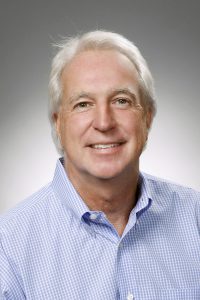
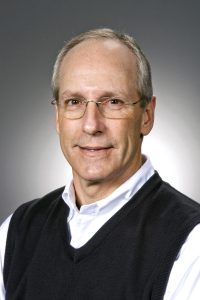
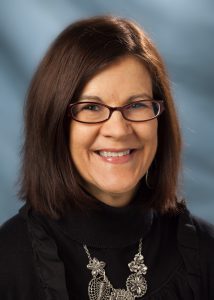
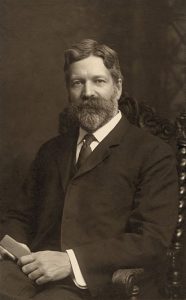










Follow Us